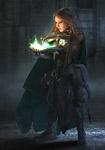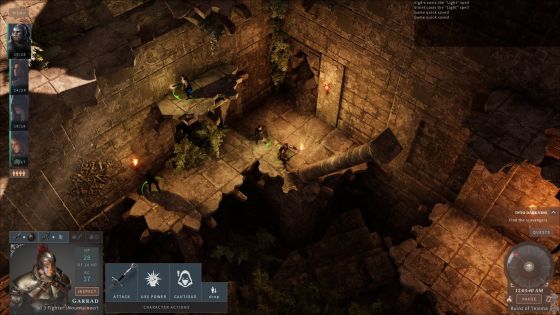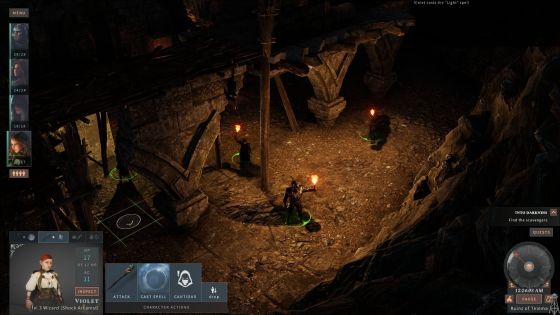Solasta Gamescom Preview

At Gamescom, I was shown Solasta: Crown of the Magister by Matthieu Girard of Tactical Adventures, who has been in the industry for 20 years and it has been a dream of him to create an RPG like Solasta, which he has been thinking about for a long time, well before Tactical Adventures was founded, which is about a year ago. He has been a big fan of the Gold Box games and obviously played a lot of games since then, of which Baldur's Gate and X-Com were mentioned. His vision for Solasta is to create a game that mixes the best part of the games he likes. As a basis for the game the 5th edition ruleset is used as described in the D&D Open Game License, System Reference Document (https://dnd.wizards.com/articles/features/systems-reference-document-srd). The game will stay as close as possible to this document, which results in almost everything requiring a dice roll, which means that there will be quite some randomness and the outcome depends on your abilities and on being lucky.
I was shown a half hour of the demo that will be made available during the upcoming Kickstarter for the game. The demo will contain as much as possible of the game elements, features, art and music the game has to offer. The demo is however not a segment of the game, it is a stand-alone adventure specifically made for the demo and to showcase what is possible with the game.
For the Kickstarter their main goal is to build a supporting community and receive community feedback so they can make the best game possible, although it is probably also beneficial to the game if they raise a good sum of money in the process. But, regardless of the outcome of the Kickstarter, the game will be made, even if the Kickstarter would fail to raise the required funds.
In the game you play a team of four characters. There is no main player character, you get to create the four characters from the start, at least in the final game. In the demo you get four pre-made characters: a fighter, a rogue, a cleric and a wizard. You cannot change the party once you have started. You will also not find any new party members during the game. Occasionally though, someone could join your party for a short while. Each of the party members has its own background and alignment and will respond to the actions of other party members accordingly while playing the game. But this will not lead to any of the party members leaving, as there is no way to replace that character.
The character sheets will provide all the information about each of the characters. There will also be extra information provided for what the text and numbers in the character sheets mean by means of tooltips and such. There is also a very extensive description available for things like spells, which will explain in detail what their effects are.
The demo that was presented to me, has a mission where the party meets a group of people they were sent to help. It started with a cut scene where the characters interact with each other talking about what their goal is. Not all of the 4 team members necessarily have the same goal. Once the cut scene ended the fully voiced interactive dialogs started. Unlike other RPGs the dialogs are not shown as a set of options you can select from. Instead, several of the characters have the option to say one thing. What they say depends on their class, alignment, background, etc. The knight is a bit straight forward, the rogue wants to benefit himself and the cleric wants to help. The player gets to choose one of the four available dialog options. After selecting a dialog option a D20 is rolled and a check is made against the attribute related to that dialog option. So depending on the rolled dice and the attributes of the character you can succeed or not. Failing will require the need to find another way to move on and the game has been designed in such a way that there will always be another option.
If you would replay the game at a later stage with a different set of characters, you will also get different dialog options. But, due to the randomness, even with the same party the outcome might be different. As a result the consequences in the game will differ as well.
One of the important elements Matthieu highlighted is the verticality in the game. It offers various heights in the game that can be used by your party but also by your opponents to navigate in 3D and to jump, climb or even fly around. It also allows for pushing objects over the edge of a wall and making it drop on one of your opponents below you, or pushing against a column to make it fall over so that it reaches the other side of a big gap, thus making it possible to cross to the other side. There aren't any areas that have no verticality, except perhaps a few outdoor maps with flat terrain. There are no rules in the SRD that give you a bonus when you fire an arrow from a higher position, with the exception of The Darkweaver, a subclass of the rogue, who has a damage bonus when enemies are below that character.
Another important element that was mentioned, is lighting. In dungeons it is often required to light your environment, so one of your characters should bring something that can be used as a light source or you can use spells to accomplish the same. Not having any light can be very disadvantageous in a fight, especially when the opponents have dark vision. Another reason to bring light is that some monsters are afraid of light, which gives you a bonus. Light sources will have a duration, a torch for example will last for one hour, so you have to make sure you stock up on your light sources.
The combat in Solasta is turn-based and starts with a dice being rolled for initiative. There is a lot of of dice rolling in Solasta. Allof which is automated and takes place in the background, but for the hardcore fans there is a window that shows the results of the dice rolling and in what way you have succeeded or not.
Each of the characters can equip two weapons to switch between during combat, like a melee and a ranged weapon, or two daggers for a rogue. This first combat showed some of the verticality where a few spiders were at higher positions, but it didn't look too difficult. A bit more complicated fight later in the demo, involved some orcs. For this the sneaking option the game has, was used. When sneaking a detection circle is shown for each of the characters. This detection circle will become smaller when your character enters stealth mode. Going into stealth allowed the party to position themselves strategically above the orcs and attack them with ranged weapons and spells first, but also to shove a crate over the edge upon one of the orcs. This allowed to use the height to get some damage to the orcs, before they were able to reach any of our party members. Following the rules a reaction system has been implemented that allows for performaing a reaction whenever you are provoked into making one by your opponent. Characters will have more reaction options when they increase in level. Some of these reactions are performing an attack of opportunity or reducing your damage when you fall. A search in the SRD shows that there are over 90 occurrences of the word 'reaction', so there will be quite some reactions to choose from. Each character has one reaction per round.
The tactical fights are a big part of the game, but the developers do want to provide plenty of opportunities for exploring the world and learn more about it by investigating objects and reading books and inscriptions. Matthieu told me that it is a story driven game, with a campaign and an epic quest, but battles are a substantial part of the game. Although in some situations it is possible to avoid entering a battle, by sneaking or even talking you out of combat. There is however no reward for that at this point in time, but it is being discussed how the player should be rewarded for not fighting.
Solasta is single player only. There are no plans at the moment to release the game with any multiplayer options. The game has been designed to be played with a party of 4 characters. At the moment there is not something implemented that would allow the game to be played with a single character only, but players could try this out for themselves, by getting 3 party members killed and not resurrecting them. This allows to level up faster because all of the experience points are awarded to the one remaining character. Playing with one character does however not fit the narration of the game and the options you have during dialog as there will be only one dialog option to choose from, which might be limiting your gameplay, but I'm sure someone out there will try this.
A lot of what was shown to me gave me a good vibe. The presentation was focused on the combat part quite a bit, so I personally would be interested to learn more about the exploration side of things, but I guess I should wait for the demo for that. As it stands now, this is definitely a game that I look forward to be playing.
The Kickstarter for Solasta will start September 3rd.
To conclude, here is a short gameplay video, showing some of the decribed elements.

Information about
Solasta: Crown of the MagisterDeveloper: Tactical Adventures
SP/MP: Single-player
Setting: Fantasy
Genre: RPG
Combat: Turn-based
Play-time: 20-40 hours
Voice-acting: Full
Regions & platforms
Internet
· Homepage
· Platform: PC
· Released: 2021-05-27
· Publisher: Tactical Adventures
More information






